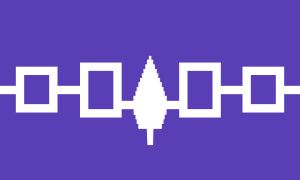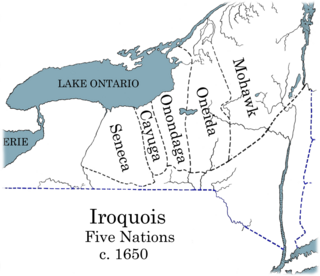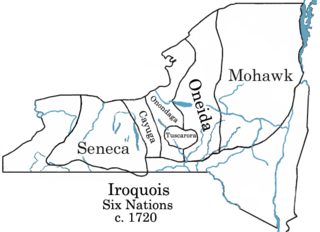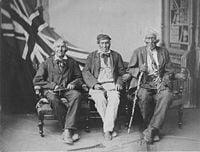Iroquois
- For other uses, see Iroquois (disambiguation).
| Iroquois Haudenosaunee | ||||||
|---|---|---|---|---|---|---|
| Total population | ||||||
| approx. 125,000 (30,000 to 80,000 in the U.S. 45,000 in Canada) | ||||||
| Regions with significant populations | ||||||
| ||||||
| Languages | ||||||
| Mohawk, Oneida, Onondaga, Cayuga, Seneca, Tuscarora, English, French | ||||||
| Religions | ||||||
| Christianity, Longhouse religion |
The Iroquois Confederacy (also known as the "League of Peace and Power"; the "Five Nations"; the "Six Nations"; or the "People of the Long house") is a group of First Nations/Native Americans that originally consisted of five tribes: the Mohawk, the Oneida, the Onondaga, the Cayuga, and the Seneca. A sixth tribe, the Tuscarora, joined after the original five nations were formed. They are often referred to as Iroquois. However they should be called the Haudenosaunee as Iroquois meant Rattlesnake, and was an insult.
At the time Europeans first arrived in North America, the Confederacy was based in what is now the northeastern United States and southern Canada, including New England, upstate New York, and Pennsylvania, Ontario, and Quebec.
History
Prehistoric period

The members of this Confederency speak different languages of the same Iroquoian family, suggesting a common historical and cultural origin, but diverging enough so that the languages have become different.
The Union of Nations was established prior to major European contact, complete with a constitution known as the Gayanashagowa (or "Great Law of Peace") with the help of a memory device in the form of special beads called wampum that have inherent spiritual value (wampum has been inaccurately compared to money in other cultures). Most anthropologists have traditionally speculated that this constitution was created between the middle 1400s and early 1600s. However, recent archaeological studies have suggested the accuracy of the account found in oral tradition, which argues that the federation was formed around August 31, 1142 based on a coinciding solar eclipse (see Fields and Mann, American Indian Culture and Research Journal, vol. 21, #2). Some Westerners have also suggested that the Great Law of Peace was written with European help,[citation needed] although some dismiss this notion as racist.
Dealing with Europeans
By 1677, the Iroquois formed an alliance with the English through an agreement known as the Covenant Chain. Together, they battled the French, who were allied with the Huron, another Iroquoian people but a historic foe of the Confederacy.
The two prophets, Ayonwentah (frequently misspelled as Hiawatha due to the Longfellow poem) and "Deganawidah, The Great Peacemaker", brought a message of peace to squabbling tribes. The tribes who joined the League were the Seneca, Onondaga, Oneida, Cayuga and Mohawks. Once they ceased most infighting, they rapidly became one of the strongest forces in seventeenth and eighteenth century northeastern North America.
According to legend, an evil Onondaga chieftain named Tadadaho was the last to be converted to the ways of peace by The Great Peacemaker and Ayonwentah, and became the spiritual leader of the Haudenosaunee. This event is said to have occurred at Onondaga Lake near Syracuse, New York. The title Tadadaho is still used for the league's spiritual leader, the fiftieth chief, who sits with the Onondaga in council, but is the only one of the fifty chosen by the entire Haudenosaunee people. The current Tadadaho is Sid Hill of the Onondaga Nation.

The League engaged in a series of wars against the French and their Iroquoian-speaking Wyandot ("Huron") allies. They also put great pressure on the Algonquian peoples of the Atlantic coast and what is now boreal Canadian Shield region of Canada and not infrequently fought the English colonies as well. During the seventeenth century, they are also credited with having conquered and/or absorbed the Neutral Indians and Erie Tribe to the west as a way of controlling the fur trade, even though other reasons are often given for these wars.
According to Francis Parkman, the Iroquois were at the height of their power in the seventeenth century, with a population of about twelve thousand people. League traditions allowed for the dead to be symbolically replaced through the "Mourning War", raids intended to seize captives to replace lost compatriots and take vengeance on non-members. This tradition was common to native people of the northeast and was quite different from European settlers' notions of combat.
Four delegates of the Iroquoian Confederacy, the "Indian kings", travelled to London, England, in 1710 to meet Queen Anne in an effort to cement an alliance with the British. Queen Anne was so impressed by her visitors that she commissioned their portraits by court painter John Verelst. The portraits are believed to be some of the earliest surviving oil portraits of Aboriginal peoples taken from life.[1]
Eighteenth century
In 1720, the Tuscarora fled north from the British colonization of North Carolina and petitioned to become the Sixth Nation. This is a non-voting position, but places them under the protection of the Confederacy.
During the French and Indian War, the Iroquois sided with the British against the French and their Algonquin allies, both traditional enemies of the Iroquois. The Iroquois hoped that aiding the British would also bring favors after the war. Practically, few Iroquois joined the fighting and the Battle of Lake George found a group of Mohawk and French ambush a Mohawk-led British column. The British government issued the Royal Proclamation of 1763 after the war, which restricted white settlement beyond the Appalachians, but this was largely ignored by the settlers and local governments.
During the American Revolution, many Tuscarora and the Oneida sided with the Americans, while the Mohawk, Seneca, Onondaga and Cayuga remained loyal to Great Britain. This marked the first major split among the Six Nations. After a series of successful operations against frontier settlements, led by the Mohawk leader Joseph Brant and his British allies, the United States reacted with vengeance. In 1779, George Washington ordered Col. Daniel Brodhead and General John Sullivan to lead expeditions against the Iroquois nations to "not merely overrun, but destroy," the British-Indian alliance. The campaign successfully ended the ability of the British and Iroquois to mount any further significant attacks on American settlements.
In 1794, the Confederacy entered into the Treaty of Canandaigua with the United States. After the American Revolutionary War, Captain Joseph Brant and a group of Iroquois left New York to settle in Canada. As a reward for their loyalty to the English Crown, they were given a large land grant on the Grand River. Brant's crossing of the river gave the original name to the area: Brant's ford. By 1847, European settlers began to settle nearby and named the village Brantford, Ontario. The original Mohawk settlement was on the south edge of the present-day city at a location favorable for landing canoes. Prior to this land grant, Iroquois settlements did exist in that same area and elsewhere in southern Ontario, extending further north and east (from Lake Ontario eastwards into Quebec around present-day Montreal). Extensive fighting with Huron meant the continuous shifting of territory in southern Ontario between the two groups long before European influences were present.
Beliefs
These tribes, mostly members of the Iroquois nation, lived in the Northeastern territories of what is now the U.S. and Canada, from the St. Lawrence River down to the Delaware Bay and inland to the Great Lakes. Their close contact with Europeans makes investigation of their original mythology and religion extremely difficult, but core beliefs included a conception of life as a struggle between the forces of good and evil. The "All-Father," an all-embracing deity, was formless and had little contact with humans. Spirits animated all of nature and controlled the changing of the season. Key festivals coincided with the major events of the agricultural calendar.
Features of Confederacy
The general features of the Iroquois Confederacy may be summarized in the following propositions:
- The confederacy was a union of Five Tribes, composed of common gentes, under one government on the basis of equality; each Tribe remaining independent in all manners pertaining to local self-government.
- It created a Great Council of Sachems, who were limited in number, equal in rank and authority, and invested with supreme powers over all matters pertaining to the Confederacy.
- Fifty Sachemships were created and named in perpetuity in central gentes of the several Tribes; with power in these gentes to fill vacancies, as often as they occurred, by election from among their respective members, and with the further power to depose from office for cause; but the right to invest these Sachems with office was reserved to the General Council.
- The Sachems of the Confederacy were also Sachems in their respective Tribes, and with the Chiefs of these Tribes formed the Council of each, which was supreme over all matters pertaining to the Tribe exclusively.
- Unanimity in the Council of the Confederacy was made essential to every public act.
- In the General Council the Sachems voted by Tribes, which gave to each Tribe a negative upon the others.
- The Council of each Tribe had power to convene the General Council; but the latter had no power to convene itself.
- The General Council was open to the orators of the people for the discussion of public questions; but the Council alone decided.
- The Confederacy had no chief Executive Magistrate, or official head.
- Experiencing the necessity for a General Military Commander they created the office in a dual form, that one might neutralize the other. The two principal War-chiefs were made equal in powers.[2]
Originally the principal object of the council was to raise up sachems to fill vacancies in the ranks of the ruling body occasioned by death or deposition; but it transacted all other business which concerned the common welfare. Eventually the council fell into three kinds, which may be distinguished as Civil, Mourning, and Religious. The first declared war and made peace, sent and received embassies, entered into treaties with foreign tribes, regulated the affairs of subjugated tribes, as well as other general welfare issues. The second raised up sachems and invested them with office, termed the Mourning Council (Henundonuhseh) because the first of its ceremonies was the lament for the deceased ruler whose vacant place was to be filled. The third was held for the observance of a general religious festival, as an occasion for the confederated tribes to united under the auspices of a general council in the observance of common religious rites. But as the Mourning Council was attended with many of the same ceremonies it came, in time, to answer for both. It became the only council they held when the civil powers of the confederacy terminated with the supremacy over them of the state.[2]
The Haudenosaunee
The combined leadership of the Nations is known as the Haudenosaunee. It should be noted that "Haudenosaunee" is the term that the people use to refer to themselves. Haudenosaunee means "People of the Long House." The term is said to have been introduced by The Great Peacemaker at the time of the formation of the Confederacy. It implies that the Nations of the confederacy should live together as families in the same longhouse. Symbolically, the Seneca were the guardians of the western door of the "tribal long house," and the Mohawk were the guardians of the eastern door.
The word "Iroquois" has two potential origins. First, the Haudenosaunee often ended their oratory with the phrase "hiro kone"; "hiro" which translates as "I have spoken", "kone" which can be translated several ways, the most common being "in joy", "in sorrow", or "in truth". "Hiro kone" to the French encountering the Haudenosaunee would sound like "Iroquois", pronounced iʁokwa in French. An alternate possible origin of the name Iroquois is reputed to come from a French version of a Huron (Wyandot) name—considered an insult—meaning "Black Snakes." The Iroquois were enemies of the Huron and the Algonquin, who were allied with the French, due to their rivalry in the fur trade.
The Iroquois nations' political union and democratic government has been credited by some as one of the influences on the United States Constitution. However, that theory has fallen into disfavor among many historians, and is regarded by others as mythology. Historian Jack Rakove writes: "The voluminous records we have for the constitutional debates of the late 1780s contain no significant references to the Iroquois." Researcher Brian Cook writes: "The Iroquois probably held some sway over the thinking of the Framers and the development of the U.S. Constitution and the development of American democracy, albeit perhaps indirectly or even subconsciously... However, the opposition is probably also correct. The Iroquois influence is not as great as [some historians] would like it to be, the framers simply did not revere or even understand much of Iroquois culture, and their influences were European or classical - not wholly New World."
Member nations
The first five nations listed below formed the original Five Nations (listed from west to north); the Tuscarora became the sixth nation in 1720. The first five nations listed below formed the original Five Nations (listed from west to north); the Tuscarora became the sixth nation in 1720.
| English | Iroquoian | Meaning | 17th/18th century location |
|---|---|---|---|
| Seneca | Onondowahgah | "People of the Great Hill" | Seneca Lake and Genesee River |
| Cayuga | Guyohkohnyoh | "People of the Great Swamp" | Cayuga Lake |
| Onondaga | Onundagaono | "People of the Hills" | Onondaga Lake |
| Oneida | Onayotekaono | "People of Upright Stone" | Oneida Lake |
| Mohawk | Kanien'kéhaka | "People of the Flint" | Mohawk River |
| Tuscarora1 | Ska-Ruh-Reh | "Shirt-Wearing People" | From North Carolina2 |
1 Not one of the original Five Nations; joined 1720.
2 Settled between Oneidas and Onondagas.

|

|
Modern population
The total number of Iroquois today is hard to establish. About 45,000 Iroquois lived in Canada in 1995. In the 2000 census, 80,822 people in the United States claimed Iroquois ethnicity, with 45,217 of them claiming only Iroquois background. However, tribal registrations in the United States in 1995 numbered about 30,000 in total.
| Location | Seneca | Cayuga | Onondaga | Tuscarora | Oneida | Mohawk | Combined |
|---|---|---|---|---|---|---|---|
| Ontario | 3,970 | 14,051 | 17,6031 | ||||
| Quebec | 9,631 | ||||||
| New York | 7,581 | 448 | 1596 | 1,200 | 1,109 | 5,632 | |
| Wisconsin | 10,309 | ||||||
| Oklahoma | 2,2002 |
1 Six Nations of the Grand River Territory.
2 Seneca-Cayuga Tribe of Oklahoma.
Haudenosaunee clans
Within each of the six nations, people are divided into a number of matrilineal clans. The number of clans varies by nation, currently from three to eight, with a total of nine different clan names.
| Seneca | Cayuga | Onondaga | Tuscarora | Oneida | Mohawk |
|---|---|---|---|---|---|
| Wolf | Wolf | Wolf | Wolf | Wolf | Wolf |
| Bear | Bear | Bear | Bear | Bear | Bear |
| Turtle | Turtle | Turtle | Turtle | Turtle | Turtle |
| Snipe | Snipe | — | Snipe | — | Snipe |
| Deer | — | Deer | Deer | — | — |
| Beaver | — | Beaver | Beaver | — | — |
| Heron | Heron | — | — | — | — |
| Hawk | — | Hawk | — | — | — |
| — | — | Eel | Eel | — | — |
Government

The Iroquois have a representative government known as the Grand Council. Each tribe sends chiefs to act as representatives and make decisions for the whole nation. The number of chiefs has never changed.
- 14 Onondaga
- 10 Cayuga
- 9 Oneida
- 9 Mohawk
- 8 Seneca
- 0 Tuscarora
Modern tribal communities
- Canada
- Kahnawake Mohawk in Quebec
- Kanesatake Mohawk in Quebec
- Mohawk Nation of Akwesasne in Ontario
- Onyota'a:ka First Nation of Oneida in Ontario
- Six Nations of the Grand River Territory in Ontario
- Tyendinaga Mohawk in Ontario
- Wahta Mohawk in Ontario
- United States
- Cayuga Nation in New York
- Ganienkeh Mohawk — not federally (US/CAN) controlled
- Kanatsiohareke Mohawk — not federally recognized
- Onondaga Nation in New York
- Oneida Indian Nation in New York
- Oneida Tribe of Indians in Wisconsin
- St. Regis Band of Mohawk Indians in New York
- Seneca Nation of New York
- Seneca-Cayuga Tribe of Oklahoma
- Tuscarora Nation of New York
Prominent people of Iroquois ancestry
- Frederick Alexcee, artist (also of Tsimshian ancestry)
- Ki Longfellow, novelist (also of French and Irish ancestry]
- Jay Silverheels, actor, of Canadian Mohawk origin
C
Footnotes
- ↑ "The Four Indian Kings" in Virtual Vault, an online exhibition of Canadian historical art at Library and Archives Canada
- ↑ 2.0 2.1 Morgan, Lewis H. (1907). Ancient Society. Chicago: Charles H. Kerr & Company, 130-131, 138-139.
ReferencesISBN links support NWE through referral fees
- "The Four Indian Kings" in Virtual Vault, an online exhibition of Canadian historical art at Library and Archives Canada
- "The Ordeal of the Longhouse", by Daniel K. Richter
- The Adventures of Tom Sawyer, by Mark Twain
- For a detailed account of Iroquois actions during the American Revolution, see: Williams, Glenn F. Year of the Hangman: George Washington's Campaign Against the Iroquois Yardley: Westholme Publishing, 2005.
- Who Are the Haudenosaunee?
- Oldest Living Participatory Democracy
- Iroquois Indian Museum, Howes Cave, NY
See also
|
|
|
|
External links
- Ganienkeh.net
- Haudenosaunee Home Page : the official source of news and information from the Haudenosaunee.
- Gayanashagowa
- History and origin of the Five Nations
- Long list of Iroquois links
- The Sullivan-Clinton Campaign Hits Iroquoia, 1779
- David Cusick’s Sketches of Ancient History of the Six Nations (1828)
- Iroquois Home Page
- Iroquois Confederacy and the Influence Thesis : an examination of theories for and against Iroquois influence on American democratic thought.
- The Documentary History of the State of New York, Vol. 1, Ch. I. Papers relating to the Iroquois and other Indian Tribes. 1666-1763
| Iroquois Confederacy | |
|---|---|
| Nations | Cayuga · Mohawk · Oneida · Onondaga · Seneca · Tuscarora |
| Topics | Economy · Languages · Mythology · Great Law of Peace · The Great Peacemaker |
Credits
New World Encyclopedia writers and editors rewrote and completed the Wikipedia article in accordance with New World Encyclopedia standards. This article abides by terms of the Creative Commons CC-by-sa 3.0 License (CC-by-sa), which may be used and disseminated with proper attribution. Credit is due under the terms of this license that can reference both the New World Encyclopedia contributors and the selfless volunteer contributors of the Wikimedia Foundation. To cite this article click here for a list of acceptable citing formats.The history of earlier contributions by wikipedians is accessible to researchers here:
The history of this article since it was imported to New World Encyclopedia:
Note: Some restrictions may apply to use of individual images which are separately licensed.

